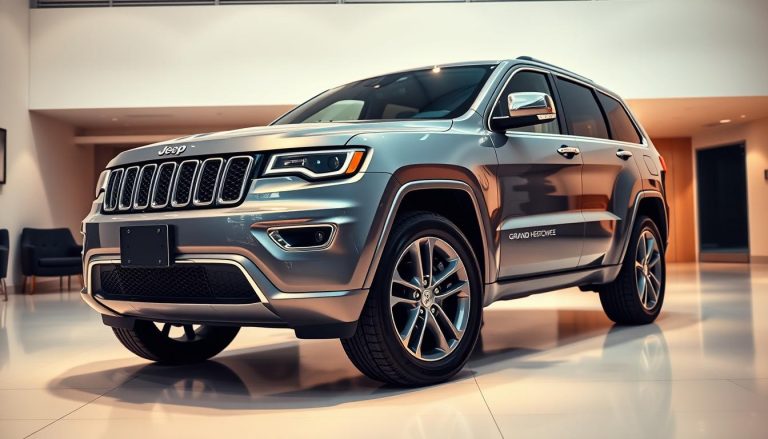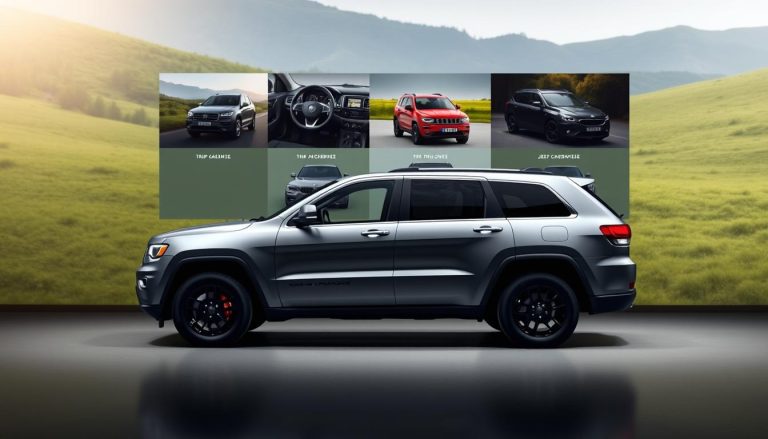Years to Avoid When Buying a Jeep Wrangler
The Jeep Wrangler is known for its tough look and ability to tackle different terrains. But, some years have been marked by issues that raise both reliability and maintenance cost concerns. Those interested in buying should look for a Jeep Wrangler buying guide that points out which years to steer clear of for a trouble-free purchase.
Knowing how the Jeep Wrangler depreciates by year is key to making a smart buy and not a regrettable one. We’ll point out the years with ongoing issues, including mechanical and safety worries. This way, you can make a choice that’s informed.
Jeep Wrangler Model Years: Changes Over Time
The Jeep Wrangler has a rich history that car lovers admire. It’s well-known for its ability to handle tough off-road trips and its unique look. But, even with its great image, some years of the Jeep Wrangler had big problems that buyers need to know about. It’s important to know which Jeep Wrangler years to steer clear of to have a good experience as an owner.
Some of the worst years for the Jeep Wrangler had engine and transmission issues. These problems hurt the Wrangler’s reputation as a reliable and strong vehicle. Knowing about these years can help buyers choose wisely.
Jeep has made many improvements over the years. But, it’s still essential for people looking to buy a Wrangler to be careful about certain years. These years had several issues that made them less desirable. In this article, we’ll look at the Jeep Wrangler years to avoid. We’ll talk about the biggest problems and focus on the years that were not great for buying based on what Wrangler owners have said.
What Year Jeep Wrangler to Avoid
The Jeep Wrangler is loved by many, but not all years were great. It helps to know what year Jeep Wrangler to avoid to dodge expensive fixes later. The least reliable years are 2007, 2008, 2012, 2014, and 2018. These years faced many issues and recalls, hurting their dependability.
- 2007: The JK model’s debut year had its share of woes. Problems with steering and suspension led to many recalls.
- 2008: Safety worries continued, making this year less appealing to buyers.
- 2012: It had a high number of recalls and ongoing engine and transmission problems.
- 2014: Known for oil housing leaks and brake system issues, making it infamous for mechanical troubles.
- 2018: Steering issues and expensive repairs marred this year, posing challenges for owners.
Knowing what year Jeep Wrangler to avoid helps buyers choose wisely. It lets them evade the unreliable Jeep Wrangler years known for trouble.
Common Issues with Jeep Wrangler Models
Jeep lovers often worry about reliability, especially with the common issues of Jeep Wrangler models. Problems with engines and transmissions are big concerns. These issues are especially true for Wranglers made between 1997 and 2006.
Engine Problems
Jeep Wrangler engines often face troubles like broken seals and oil leaks. These issues tend to happen because of loose bolts and manifolds that aren’t tight enough. Engines overheating is another big problem, leading to more damage and expensive fixes.
Transmission Failures
The transmission in many Jeep Wranglers can be problematic. Owners frequently deal with leaks and unreliable gauge readings. There’s also a common problem with the vehicle shuddering a lot while it’s being driven. These issues make the Wrangler less reliable and more costly to fix.
Why 2007 Jeep Wrangler Is Problematic
The 2007 Jeep Wrangler brought in the JK model, exciting off-road lovers. But soon, a lot of problems started appearing, making people rethink their choice.
Debut of the JK Model
The JK model of the 2007 Jeep Wrangler arrived with big celebrations. It featured a wider wheelbase and looked different. Yet, the excitement didn’t last long. The Wrangler faced many issues, like the dreaded “death wobble,” because of these updates.
Steering and Suspension Woes
The steering and suspension of the 2007 Jeep Wrangler caused big troubles. Owners felt sudden shakes, especially on bumpy roads and highways. This shaking, known as the “death wobble,” made the Jeep uncomfortable and risky to drive.
High Recall Rates
The 2007 Jeep Wrangler had a lot of recalls, focusing on safety issues. Problems with airbags and the Totally Integrated Power Module (TIPM) were critical. These recalls raised questions about how reliable the Jeep was, frustrating many owners.
Here’s a table that sums up the main issues and recalls for the 2007 Jeep Wrangler.
| Issue | Description | Recall Instances |
|---|---|---|
| Steering and Suspension | Severe shaking and instability often leading to the “death wobble” | Multiple |
| Faulty Airbags | Defective airbags posing safety hazards during collisions | High |
| TIPM Failures | Inconsistent power management affecting various systems | Significant |
Safety Concerns in 2008 Jeep Wrangler
The 2008 Jeep Wrangler has many safety worries. It often faces problems with its transmission and electrical systems. Another big issue is the Takata airbags not working right in crashes, putting people at risk. There were also troubles with the Totally Integrated Power Module (TIPM) that made the car act up. This hurt how much drivers could trust and enjoy their vehicle.
In more detail, the TIPM’s faulty wiring caused unexpected power drops and the engine to suddenly stop. These glitches made driving unsafe and raised the cost of upkeep for the owners. The car’s safety and reliability reputation took a hit because of these problems.
Here is a snapshot of the major safety issues:
| Problem | Description |
|---|---|
| Takata Airbag Malfunction | Deployment failures, leading to ineffective crash protection. |
| TOTALLY Integrated Power Module (TIPM) Issues | Erratic vehicle behavior due to faulty wiring and control systems. |
These severe safety issues with the 2008 Jeep Wrangler show why it’s vital for buyers to look into them closely before buying. Being informed about these problems helps make safer vehicle choices and keeps everyone safer on the road.
The Unreliable 2012 Jeep Wrangler
The 2012 Jeep Wrangler is known for its trouble with mechanics and electronics. This model year stood out because of its many recalls. It also had engine and transmission issues. This made many Jeep fans stay away from it.
High Number of Recalls
The 2012 Jeep Wrangler had a lot of recalls, which was a big downside. Problems like engine stalling and failures in the Totally Integrated Power Module (TIPM) were common. These recalls showed how unreliable this model year was. It worried many people who wanted to buy a Jeep Wrangler.
Engine and Transmission Issues
Engine problems made the 2012 Jeep Wrangler notorious. Owners often complained about the engine stalling, making weird noises, and not giving enough power. The transmission problems couldn’t be ignored either. They led to poor power delivery and required expensive repairs often. These issues made the 2012 Jeep Wrangler unreliable for people looking to buy one.
Here’s a closer look at the common problems in the 2012 Jeep Wrangler:
| Problem Area | Details |
|---|---|
| Engine | Frequent stalling, unusual noises, reduced power |
| Transmission | Inadequate power delivery, frequent repairs |
| TIMP | Failures leading to engine stalling |
2014 Jeep Wrangler and Its Mechanical Failures
The 2014 Jeep Wrangler has some mechanical issues that worry drivers. Oil leaks and brake system troubles are big concerns.
Oil Housing Leaks
The 2014 Jeep Wrangler often has oil leaks due to a design flaw in the oil housing. This leak is not just messy; it can harm the engine badly if it’s not fixed fast. It’s important to check it often and fix it right away to avoid bigger problems.
Brake System Concerns
Brake issues are also a big problem for the 2014 Jeep Wrangler. The brake pads and rotors wear out too fast, making the brakes less effective. This means Jeep owners need to do regular maintenance and sometimes spend a lot on repairs to keep their vehicle safe.
Why the 2018 Jeep Wrangler Faces Issues
The 2018 Jeep Wrangler had new features like better fuel usage and stronger engines. But, it faced big problems with its reliability and how happy owners were with it.
Steering System Problems
The steering system didn’t work well and was a big issue. Drivers often felt a scary wobble, making it hard and unsafe to drive. This problem, called the “death wobble,” showed the 2018 model had serious design issues in its steering.
Because of these issues, fixing the steering was often needed and cost a lot of money.
High Repair Costs
Steering wasn’t the only problem; fixing the 2018 Jeep Wrangler was expensive. Owners had to pay a lot for steering and suspension repairs. These costs made many question their vehicle’s value, hurting the 2018 Jeep Wrangler’s image.
Electrical System Malfunctions
To really understand the electrical issues in various Jeep Wrangler models, we need to focus on the Totally Integrated Power Module (TIPM). This module plays a huge role in controlling the electrical systems of the vehicle. When it fails, it leads to many problems.
Troubles with the Totally Integrated Power Module (TIPM)
Jeep Wrangler owners have faced a lot of issues because of TIPM problems. For example, headlights might turn off on their own, or windshield wipers could start without anyone touching them. These aren’t just small issues. They can actually make the vehicle less safe and reliable.
Common Electrical Failures
But it’s not just the TIPM that causes trouble. There are other electrical parts that can fail too. Some owners have had problems with their key fobs and wireless controls not working right. This can be really frustrating. These failures can show up in ways like:
- Non-functional remote key fobs
- Unresponsive power windows and locks
- Faulty ignition systems
To keep your Jeep Wrangler running well and to ensure it’s safe, it’s important to fix these electrical issues quickly.
Jeep Wrangler Models with Poor Production Quality
Some Jeep Wrangler models have been criticized for their poor production quality. They have issues with mechanics and electricity, which hurts their performance and trustworthiness. The biggest problems include oil leaks and engines that overheat. Poor quality control when these were made is to blame, leading to parts failing earlier than they should.
Certain models stood out because their production was all over the place, making some more reliable than others. This inconsistency made owners unhappy due to unplanned repair costs.

- Frequent oil leaks
- Engine overheating problems
- Premature failure of critical components
- Frequent electrical malfunctions
- Ineffective quality control measures
Knowing about these issues can guide future buyers. Those thinking about buying should be careful with models known for poor quality. They might want to look at other years that are more reliable.
Structural Weaknesses in Jeep Wrangler
Recent studies and feedback from drivers show a few key issues in some Jeep Wrangler models. These issues are important to fix since they can greatly impact the vehicle’s safety and control. Specifically, problems with welds and the overall strength of the body and frame stand out. These can be noticed during normal driving.
Improper Welds
The biggest structural problem with Jeep Wranglers is the welding, especially on the steering shaft. These bad welds can cause big problems with how the car handles. This is true at high speeds or in tight spaces. These issues might not be obvious at first. That’s why it’s key for Jeep Wrangler owners to regularly check their cars. They should also seek professional help to make sure everything is safe to use.
Body and Frame Issues
Jeep Wranglers also have issues with their body and frame. These problems can make the car less safe in a crash and more likely to get damaged in small accidents. These problems can show up as gaps in the body, doors that don’t line up right, or even cracked frames. Owners should regularly check their car’s body and frame. They should fix any problems quickly to ensure the car is safe to drive.
| Structural Weakness | Impacted Components | Potential Consequences |
|---|---|---|
| Improper Welds | Steering Shaft | Handling Problems |
| Body Issues | Panels & Doors | Misalignment & Gaps |
| Frame Problems | Vehicle Frame | Cracks & Structural Damage |
Design Flaws in Jeep Wrangler Models
Various Jeep Wrangler models have been criticized by both casual drivers and off-road fans. Common complaints focus on the vehicle’s suspension system. This leads to a bumpier ride than what you get with other cars.
There’s also an issue with how these cars handle, especially the ones with automatic transmissions. It’s not as smooth as it should be.
Another big problem is that some models don’t keep an eye on transmission fluid well. This can cause overheating and increase the chance of leaks. These design flaws not only hurt the Jeep’s performance but also can make upkeep more expensive.
Furthermore, some models face structural issues, like bad welds. This can lower the car’s strength and safety.
| Model Year | Design Flaw | Impact |
|---|---|---|
| 2007 | Suspension System | Rough Ride |
| 2012 | Transmission Fluid Monitoring | Overheating and Leaks |
| 2014 | Improper Welds | Structural Weakness |
Demystifying the Death Wobble
The Jeep Wrangler death wobble is a well-known problem for many owners. It causes the front of the Jeep to shake violently, usually when hitting bumps or driving fast. This makes it hard to control the vehicle.
What is the Death Wobble?
When the Jeep Wrangler death wobble hits, it feels like the steering wheel is moving side to side by itself. It makes steering the vehicle stable very hard, which can be dangerous.
To fix the death wobble, you might have to slow down or even stop. The reasons vary, from bad suspension parts to the wheels not being aligned right.
Years Most Affected
Some models of the Jeep Wrangler are more likely to have the death wobble. Based on reports, the following years are most affected:
- 2007
- 2008
- 2012
- 2018
The Jeep Wrangler death wobble is common in these models, leading to needed repairs on the steering system.
Jeep Wrangler Models with High Recall Rates
When looking at Jeep Wrangler high recall rates, some years stand out due to big safety problems. The 2007, 2008, and 2012 models have seen many recalls. This affects their trustworthiness and may raise maintenance costs for new owners.
The 2007 Jeep Wrangler introduced the JK platform. Despite its fame, it faced many recalls, especially with steering and suspension. Issues with important safety features like fuel spills and brake fluid leaks caused several recalls.
In 2008, the Jeep Wrangler continued to have high recall rates. This time, issues were mainly with the airbag systems. Buyers need to be extra careful, as missed issues could lead to unexpected costs.
The 2012 model faced similar problems, keeping the recall rates high. Problems with the Totally Integrated Power Module (TIPM) and airbag defects were to blame. These issues highlight why knowing a car’s recall history is crucial to avoid surprises and safety risks.
Here’s a brief look at the years with issues and their main recall concerns:
| Model Year | Main Recall Issues |
|---|---|
| 2007 | Steering, Suspension, Fuel Overflow |
| 2008 | Airbag Systems |
| 2012 | TIPM, Airbag Defects |
Knowing about Jeep Wrangler high recall rates is key for potential buyers. The history of recalls shows why doing your homework and being careful when picking a used car is vital.
Choosing the Right Jeep Wrangler Year
When picking out a Jeep Wrangler, focus on models known for being reliable. Knowing which ones are best can prevent future troubles and save money.
Most Reliable Model Years
Jeep Wrangler models from 2019 and later are known for their safety and fewer complaints. These newer versions come with better technology. This makes them safer and more reliable for buyers.
Some older models from the early 2000s are also well-regarded. They are built tough and last a long time, especially if taken care of. People and experts alike praise these models for their lasting performance.
Customer Recommendations
Customers often recommend the 2015 and 2017 Wranglers. They say these models are dependable and have fewer mechanical problems. They are happy with their durability and overall quality.
If you’re searching for a new or an old Jeep Wrangler, focus on the most reliable years. Reviews from owners and experts can help guide you to the best choice.
Conclusion
Knowing which Jeep Wrangler years to skip is crucial for buyers. It ensures you pick a tough and dependable vehicle. We have explained the years with issues, common problems, and safety worries certain Jeep Wranglers have. This knowledge helps buyers dodge the bad choices and have a safe, dependable driving experience.
The Jeep Wrangler is famous for its off-road skills. But, some years have problems like frequent recalls and weaknesses. Avoiding these bad years will make your driving time better. You’ll see fewer surprise repairs and can trust the Jeep brand more.
Always talk to experts and check the Jeep Wrangler carefully before buying it. This guide aims to give you the facts to make smart choices. Pick the model year that meets your needs and wants. Smart buying equals many years of fun and reliable Jeep adventures.
FAQs
What are the years to avoid when buying a Jeep Wrangler?
It’s best to steer clear of the 2007, 2008, 2012, 2014, and 2018 models. They have known reliability problems and can be costly to maintain.
Why is the 2007 Jeep Wrangler problematic?
Launched as the JK model, the 2007 Wrangler had issues with its steering and suspension. This led to the “death wobble.” Recalls were frequent due to unsafe airbags and problems with the Totally Integrated Power Module (TIPM).
What common issues are found in Jeep Wrangler models?
Jeep Wranglers often face engine issues like seal leaks and transmission failures. There’s also shuddering and electrical issues because of the TIPM.
Why should the 2012 Jeep Wrangler be avoided?
The 2012 model had plenty of recalls due to the engine stalling and TIPM failures. There were also many transmission problems, making it a bad choice.
What are “death wobble” and the years most affected by it?
“Death wobble” is extreme shaking from the front steering components. It mainly affects the 2007, 2008, 2012, and 2018 models. It happens at high speeds, making driving unsafe.
How can I choose the right Jeep Wrangler year?
For a trusty Jeep Wrangler, look at models from the early 2000s or after 2019. These selections have fewer issues and come with better safety and performance.
What are the most common electrical failures in Jeep Wranglers?
Most electrical troubles involve the TIPM. This includes unpredictable headlights and windshield wipers, broken fobs, and faulty wireless controls.






